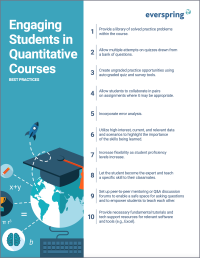Search
There are 5 results.
Tag
Tag
All (36)
Active Learning (1)
Analytics (3)
Assessments (3)
Asynchrony (3)
Backwards Design (2)
Canvas (6)
Collaboration (2)
Communication (5)
Community (2)
Content Creation (3)
Copyright (1)
Course Maintenance (5)
Course Materials (3)
Course Preparation (5)
Discussions (1)
Faculty Presence (2)
Faculty Support (1)
Feedback (2)
Generative AI (2)
Grading (2)
Learning Objectives (2)
Multimodality (3)
Qualitative courses (1)
Quantitative courses (1)
Revising (2)
Rubrics (1)
Summative Assessments (1)
Synchrony (4)
Third-Party Tools (1)
Zoom Into Online Learning
Faculty often express concern over how to maintain personal relationships with their students in an online course space; incorporating optional synchronous elements to an online course can help “put a face” to a name. Zoom, the video conferencing tool that allows you to create synchronous experiences for their students, has become ubiquitous in educational and businesses in the past two years.
Leveraging CSV Downloads
The majority of an online instructor’s course facilitation will occur within the learning management system (LMS). However, there are some tasks that can be improved or streamlined by downloading comma-separated value (CSV) files from Canvas. Running an online course requires balancing a lot of names, assignments, and deadlines, so using Microsoft Excel, Google Sheets, or another spreadsheet software can assist with course management.
Canvas Grading and Feedback: What Students See
Did you know that some forms of assignment feedback in Canvas are more obvious to students than others? Canvas has a Student View option for instructors to get a sense of what students are seeing in most general areas of their courses, but it can be challenging to determine what your actual students are experiencing when accessing your comments on their work or the rubric you’ve filled out for their submission.
Building Your Online Course With the Lister Model
You are building a course for the online environment. What an exciting adventure! When building an online course, you might use a similar method to what you used when developing a course previously, or you might use an entirely new technique. Either option is a good option. But you may have a few questions when you first begin: How do I organize my materials? How do I display my materials? How do I make sure my students work together?





